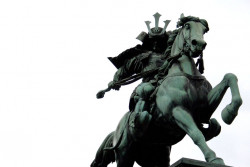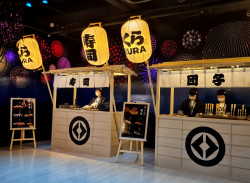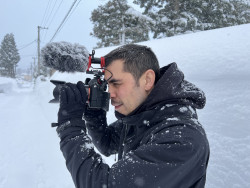
August 12, 2010
The Wrecking Crew
As officials in Chuo-ku move ahead with plans to demolish historic school buildings, local residents are struggling to make their voices heard
By Metropolis

Chuo Elementary School alumni Hideo Takahashi (left) and his son Yoshiaki on the steps of their alma mater

Akashi Elementary School
 “I remember looking out of the window and seeing a sky full of B29s fly overhead,” he tells Metropolis. “I don’t know why, but I didn’t really feel afraid. I thought they would just pass by.”
“I remember looking out of the window and seeing a sky full of B29s fly overhead,” he tells Metropolis. “I don’t know why, but I didn’t really feel afraid. I thought they would just pass by.”
Takahashi packed his belongings in a pushcart and headed over to nearby Akashi Elementary School, where residents were told to gather during an attack. Although there were many bomb shelters in the area, people were wary of using them—they were firetraps, and US strategy now included using incendiary bombs. The playground at Akashi was surrounded on three sides by the ferroconcrete school building, and residents prayed it would protect them against the fire that was engulfing much of Tokyo.
“I remember standing on the school grounds and looking north towards Asakusa,” Takahashi recalls. “Although it was night, the sky was continuously filled with flashes of bright light, like when a firework first explodes. It was terrible.”
The strength and layout of the school allowed Takahashi and others to escape death and injury that night, but many of their fellow Tokyoites were not so lucky. It’s estimated that more than 100,000 people died in the March 9-10 bombing raid—a greater number than the immediate death toll of either Hiroshima or Nagasaki. The damage to property was also unprecedented: an estimated 267,000 buildings, about one-quarter of the city, were razed.
After witnessing so much destruction, it’s no surprise that Takahashi is troubled by the demise of two schools that remained standing when so much else was lost. “If they demolish the schools, people can still learn about their history from photos or books, but it is not the same,” he says. “Besides, the schools are not in bad condition, so why must they be demolished?”
Takahashi’s son Yoshiaki is as passionate about saving the buildings as his father—so much so that he’s spearheading a grassroots campaign to save Chuo Elementary School and the others in the ward. However, his concerns go well beyond the loss of important historical and cultural heritage. He and his co-campaigners believe Chuo-ku’s plans to knock down the buildings and construct new schools, rather than restore the old ones, are riddled with problems, not least the massive cost.
Five billion of taxpayers’ yen—no small sum, especially in lean economic times—is already earmarked for the construction of the new Chuo school building, which is just one of seven schools in the district to be replaced. Chuo-ku has yet to announce the estimated cost of the entire project, but Yoshiaki thinks it will reach as high as ¥35 billion. He’s convinced that residents in the area would like to see that money spent elsewhere.
Toward that end, the grassroots group funded an independent, third-party survey to gauge local opinion. Participants were asked to rank, on a scale from 1 to 8, different ways the ward should spend funds. The results show that improved medical services was the highest priority, followed by an increase in daycare centers and facilities for the elderly. Building new schools ranked dead last.
The residents group accuses the Chuo-ku Board of Education of failing to properly consult with the people in the community who will be affected by the rebuilding projects. Yoshiaki says he and the other members have contacted the board to find out specifics of the plan no less than ten times, but they have either been ignored or, on the few occasions when they received a response, the answers were inadequate. (Chuo-ku officials did not respond to Metropolis’ request for an interview.)
“They were just paying lip service—when we asked questions about what was happening, they wouldn’t give us straight answers,” he says. “When we finally met with Board of Education staffer Mr. Endo, his answers didn’t make sense—his reasons justifying the construction of the new schools didn’t add up.”
One of these reasons was that the number of students in the area is increasing. But Yoshiaki calls this a “big lie.”
“Enrolments at [Chuo Elementary School] have actually decreased significantly over the last half century,” he says. “In 1948, there were a total of 816 pupils at the school, but in 2009 there were only 112. Even with smaller modern class sizes, the school is only at a quarter or a third of its capacity.”
The building that’s being constructed on the grounds of the former Chuo Elementary School is a massive structure in comparison to ordinary schools. It is a modern, rectangular, block-style building that will stretch to 30 meters tall. It will also incorporate a number of unusual and high-tech features, such as a top-floor playground that will be crowned by a stadium-style retractable roof. “It will look more like Keio Department Store than a school,” Yoshiaki says.
The residents group believes a building of that size and style will destroy the distinctive atmosphere of the neighborhood. On a walk around the area surrounding the school grounds, Yoshiaki points out Teppozu Park and the local Shinto shrine, Teppozu Jinja. He says that all three structures were built before the war and, together, make up the core of the district. The new school will also overshadow the surrounding residences, mostly two-story houses and small, low-lying apartment blocks.
“I was born here,” Yoshiaki says. “I went to this school. My father went to this school. A few years ago, I got married in that shrine. We have our neighborhood bon-odori festival in the park every August. This area really is a part of our life—in fact, it is our life.”







